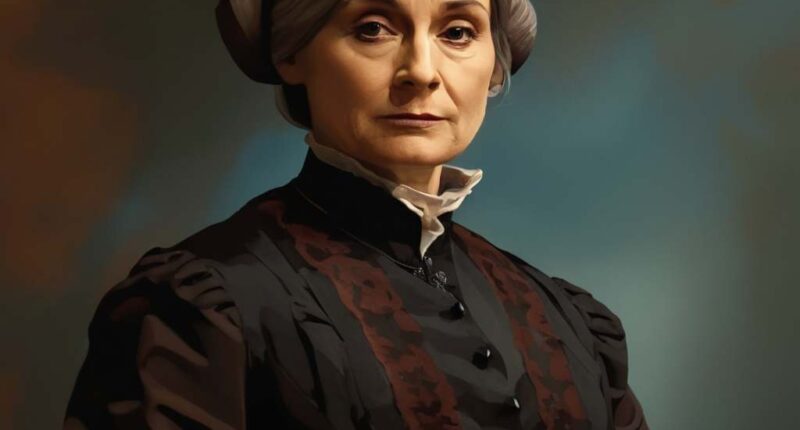Susan B. Anthony (born on February 15, 1820, in Adams, Massachusetts) is particularly remembered for her relentless advocacy for women’s suffrage and equal rights a pioneering figure in American history.
Susan B. belongs to a Quaker family, her passion for justice and dedication to challenging norms are deeply committed to social equality.
She tirelessly campaigned throughout her life for women’s rights, abolitionism, and various social reforms, leaving an indelible mark on the trajectory of American society.
Early Life:
She was born in Adams, Massachusetts, in 1820, and married Susan B. McCullough.
Her upbringing was influenced by her abolitionist and temperance father, Daniel Anthony, and her mother’s Baptist family.
Despite economic hardship, including the Panic of 1837, Anthony continued teaching and lecturing, later becoming professional.
While living in Rochester, New York, she became part of a Quaker movement working for social change.
Inspired by individuals like Frederick Douglass, she advocated for women’s rights including equal pay for equal work.
Her involvement in the women’s rights movement culminated in a lifelong commitment to activism, supporting herself financially through speaking engagements.
Susan B. Anthony’s Activism:
1. Early Activism:
Formation of NLU Alliance:
In 1866, Anthony aligned with the National Labor Union (NLU), aiming to build a broad-based political party inclusive of farmers, African Americans, and women.
Working Women’s Association (WWA):
Anthony represented the WWA, advocating for women’s rights in the workforce and supporting Hester Vaughn’s pardon, highlighting gender injustices in the legal system.
2. Split in the Women’s Movement
Formation of NWSA:
Anthony and Stanton founded the National Woman Suffrage Association (NWSA) in 1869, differing from AWSA over the Fifteenth Amendment and focusing on national suffrage.
Rivalry and Collaboration:
NWSA and AWSA competed, with differing strategies and political alliances, until their merger in 1890 as the NAWSA.
3. National Suffrage Movement
Leadership Role:
Anthony became a prominent national leader in the suffrage movement, dedicating herself fully to the cause without drawing a salary.
Campaigning and Advocacy:
Anthony’s extensive travel, lectures, and lobbying efforts contributed to suffrage wins in Wyoming and Utah, along with raising awareness and recruiting supporters.
Legal Challenges:
Anthony’s arrest and trial in United States v. Susan B. Anthony (1873) spotlighted suffrage as a national issue, leading to strategic shifts toward constitutional amendments.
4. International Engagement:
International Council of Women:
Anthony’s efforts in Europe led to the formation of the International Council of Women in 1888, fostering global alliances for women’s rights.
International Woman Suffrage Alliance:
Anthony’s vision for an international suffrage organization was realized in 1904 with the founding of the International Woman Suffrage Alliance, later renamed the International Alliance of Women.
5. Later Life and Legacy:
Continued Advocacy:
Despite retiring from NAWSA leadership, Anthony remained active in suffrage work, fundraising, and local initiatives, championing educational opportunities for women.
Enduring Influence:
Anthony’s legacy as a tireless advocate for women’s rights and suffrage continues to inspire generations, leaving an indelible mark on history.
Death:
Susan B. Anthony died at her home in Rochester, New York, on March 13, 1906, aged 86 years, of heart disease and pneumonia. Burial was in Mount Hope Cemetery.
Despite not seeing national progress for women to vote, Anthony expressed pride in the progress the movement has made, noting progress in states and legal rights for married women.
She emphasized the revolutionary nature of feminist thought and envisioned a future in which the interests and well-being of women took precedence.
Anthony’s death was widely mourned, and Clara Barton revealed the profound impact he had on men and women alike.
Anthony’s legacy as a leading initiator of suffrage will stand with the nineteenth amendment entitled the “Susan B. Anthony Amendment,”.
Her papers are preserved in esteemed libraries, and among the larger works is the printing of “Women’s Tax History” a monumental spread in six volumes.
Susan B. Anthony Coin Value:
The Greysheet Index (GSID) of the Susan B. Anthony Dollars (1979-1999) series of Dollars in the U.S.
Susan B. Anthony’s coin value contains 13 unmistakable sections with CPG® values somewhere in the range of $2.65 and $11,100.
Also, read Best Time To Enjoy!










